Lanius
Lanius, the typical shrikes, are a genus of passerine birds in the shrike family. The majority of the family's species are placed in this genus. The genus name, Lanius, is derived from the Latin word for "butcher", and some shrikes are also known as "butcher birds" because of their feeding habits.[1] The common English name "shrike" is from Old English scríc, "shriek", referring to the shrill call.[2]
| Lanius | |
|---|---|
.jpg) | |
| Great grey shrike (Lanius excubitor) | |
| Scientific classification | |
| Kingdom: | Animalia |
| Phylum: | Chordata |
| Class: | Aves |
| Order: | Passeriformes |
| Family: | Laniidae |
| Genus: | Lanius Linnaeus, 1758 |
| Type species | |
| Lanius excubitor | |
| Species | |
|
Many, see text | |
African species are known as fiscals. That name comes from the Afrikaans word fiskaal ("public official", especially a hangman), because they hang their prey on thorns for storage.
Most Lanius species occur in Eurasia and Africa, but the great grey shrike has a circumpolar distribution, and the loggerhead shrike is confined to North America. There are no members of this genus or the shrike family in South America or Australia.
Lanius shrikes are birds of open habitats typically seen perched upright on a prominent perch like a treetop or a telephone pole. They sally out for prey, taken in flight or the ground. These species primarily take large insects, but will also take small birds, reptiles and mammals. For large northern species such as the great grey, the majority of the prey will be vertebrates, especially in winter.
Despite their diet, these are not true birds of prey, and lack the strong talons of the raptors. Though they use their feet to hold smaller insects, larger prey items are impaled upon a sharp point, such as a thorn or the barbs of barbed wire. Thus secured they can be ripped open with the hooked bill.
Most Lanius shrikes are solitary, except when breeding and are highly territorial. Northern or temperate species such as the great grey and red-backed shrikes are migratory and winter well south of the breeding range.
The sexes of most species are distinguishable, the male invariably being the brighter bird where there is a difference.
There are some natural groupings within the genus, such as the seven African fiscals, the large grey species (ludovicianus, excubitor, meridionalis and sphenocercus) and the Eurasian brown-backed species (tigrinus, bucephalus, collurio, isabellinus, cristatus and gubernator). In the last group in particular, it has been difficult to define species’ boundaries, and in the past several of these shrikes have been lumped as conspecific.
The prehistoric shrike Lanius miocaenus has been described from Early Miocene fossils found at Langy, France.[3]
Taxonomy and systematics
Extant species
The genus Lanius contains the following species:
| Image | Common Name | Scientific name | Distribution |
|---|---|---|---|
%2C_Hindhede_Nature_Park%2C_Singapore_-_20060921.jpg) | Tiger shrike | Lanius tigrinus | Russia, Japan and China |
_(8077352625)~crop.jpg) | Souza's shrike | Lanius souzae | Angola to Botswana, Republic of the Congo, Democratic Republic of the Congo, Gabon, Malawi, Mozambique, Namibia, Rwanda, Tanzania and Zambia. |
| Bull-headed shrike | Lanius bucephalus | north-east China, Korea, Japan and far-eastern Russia | |
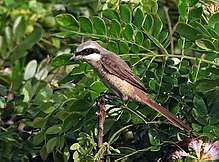 | Brown shrike | Lanius cristatus | northern Asia from Mongolia to Siberia and in South Asia, Myanmar and the Malay Peninsula |
.jpg) | Red-backed shrike | Lanius collurio | Western Europe east to central Russia |
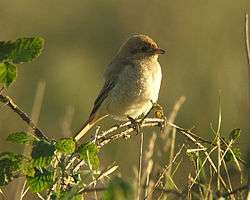 | Isabelline shrike | Lanius isabellinus | India |
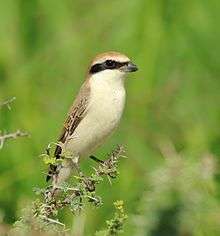 | Red-tailed shrike | Lanius phoenicuroides | south Siberia and central Asia. |
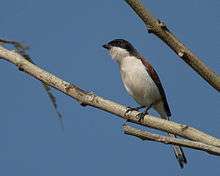 | Burmese shrike | Lanius collurioides | Bangladesh, Cambodia, China, India, Laos, Myanmar, Thailand, and Vietnam. |
| Emin's shrike | Lanius gubernator | Cameroon, Central African Republic, Democratic Republic of the Congo, Ivory Coast, Ghana, Guinea-Bissau, Mali, Nigeria, Senegal, South Sudan, and Uganda | |
_Photograph_by_Shantanu_Kuveskar.jpg) | Bay-backed shrike | Lanius vittatus | Afghanistan, Pakistan, Nepal and India |
_in_Kolkata_W_IMG_3434.jpg) | Long-tailed shrike | Lanius schach | across Asia from Kazakhstan to New Guinea |
.jpg) | Grey-backed shrike | Lanius tephronotus | Bangladesh, India (Uttarakhand), Nepal, Bhutan, China (Yunnan). |
| Mountain shrike | Lanius validirostris | Philippines. | |
 | Mackinnon's shrike | Lanius mackinnoni | Western and Central Africa, its range including Angola, Burundi, Cameroon, Congo, Democratic Republic of Congo, Equatorial Guinea, Gabon, Kenya, Nigeria, Rwanda, Tanzania and Uganda |
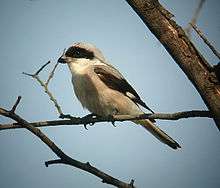 | Lesser grey shrike | Lanius minor | southern France, Switzerland, Austria, Czech Republic, Italy, the former Yugoslavia, Albania, Greece, Romania, Bulgaria and southern Russia |
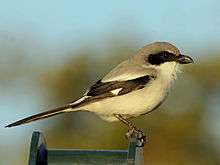 | Loggerhead shrike | Lanius ludovicianus | southern Canada, the contiguous USA and Mexico |
 | Great grey shrike | Lanius excubitor | Eurasia and northern Africa |
.jpg) | Northern shrike | Lanius borealis | North America and Siberia |
 | Iberian grey shrike | Lanius meridionalis | southern Europe |
 | Steppe grey shrike | Lanius pallidirostris | Central Asia and parts of northern China, Iran, Afghanistan and Pakistan. |
.jpg) | Chinese grey shrike | Lanius sphenocercus | China, Japan, North Korea, South Korea, Mongolia, and Russia. |
| Grey-backed fiscal | Lanius excubitoroides | Burundi, Cameroon, Central African Republic, Chad, Democratic Republic of the Congo, Ethiopia, Kenya, Mali, Mauritania, Nigeria, Rwanda, Sudan, Tanzania, and Uganda. | |
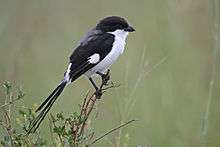 | Long-tailed fiscal | Lanius cabanisi | southern Somalia, southern and south-eastern Kenya, from the shores of Lake Victoria to the coast; and northern and eastern Tanzania south to Dar es Salaam |
.jpg) | Taita fiscal | Lanius dorsalis | southeastern South Sudan, southern Ethiopia, and western Somalia to northeastern Tanzania |
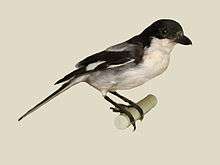 | Somali fiscal | Lanius somalicus | Djibouti, Ethiopia and Somalia in the Horn of Africa, as well as in Kenya in the African Great Lakes region |
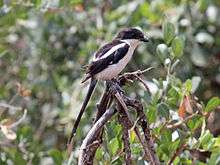 | Northern fiscal | Lanius humeralis | Sub-Saharan Africa. |
.jpg) | Southern fiscal | Lanius collaris | Sub-Saharan Africa |
| São Tomé fiscal | Lanius newtoni | São Tomé Island, São Tomé and Príncipe | |
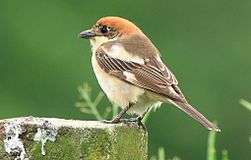 | Woodchat shrike | Lanius senator | southern Europe, northern Africa and the Middle East |
 | Masked shrike | Lanius nubicus | southeastern Europe and at the eastern end of the Mediterranean |
Former species
Formerly, some authorities also considered the following species (or subspecies) as species within the genus Lanius:
- Southern grey shrike (as Lanius meridionalis)
- Crested shriketit (as Lanius frontatus)[4]
- Rufous whistler (as Lanius macularius)[5]
- Northern variable pitohui (as Lanius kirhocephalus)[6]
- Red-whiskered bulbul (as Lanius jocosus)[7]
- Grey-cheeked bulbul (as Lanius Bres)[8]
References
- Jobling, James A (2010). The Helm Dictionary of Scientific Bird Names. London: Christopher Helm. p. 219. ISBN 978-1-4081-2501-4.
- "Shrike". Oxford English Dictionary (3rd ed.). Oxford University Press. September 2005. (Subscription or UK public library membership required.)
- Lefranc, Norbert; Worfolk, Tim (1997). Shrikes. London, UK: Pica Press. p. 19. ISBN 978-1-4081-3505-1.
- "Coracornis sanghirensis - Avibase". avibase.bsc-eoc.org. Retrieved 2017-01-29.
- Australia, Atlas of Living. "Pachycephala (Alisterornis) rufiventris rufiventris | Atlas of Living Australia". bie.ala.org.au. Retrieved 2017-02-06.
- "Pitohui kirhocephalus - Avibase". avibase.bsc-eoc.org. Retrieved 2017-01-30.
- "Pycnonotus jocosus - Avibase". avibase.bsc-eoc.org. Retrieved 2017-03-12.
- "Alophoixus bres - Avibase". avibase.bsc-eoc.org. Retrieved 2017-05-15.